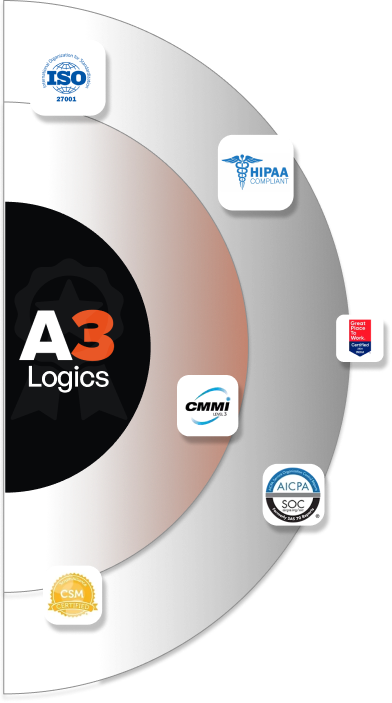Cross-Platform app development allows businesses to build a single mobile application that can run on multiple operating systems like iOS and Android. This approach helps reduce development costs and maintenance efforts compared to creating separate native apps for each platform. However, Cross-Platform app development often sacrifices some performance and access to platform-specific features.
There are many approaches to Cross-Platform app development, each with its trade-offs. Frameworks like React Native and Flutter allow coding apps using one language that compiles to iOS and Android. Hybrid approaches like Cordova and Ionic utilize web technologies to wrap an app as a native interface. Compiled languages like C# and Kotlin enables sharing of large amounts of code between platforms.
The best approach depends on an app’s complexities, desired integration with each platform, and specific business goals. Fully native apps still offer the highest performance and deepest feature access due to utilizing each platform’s native tools and APIs. But for many companies, the benefits of a Cross-Platform app development solution outweigh the disadvantages.
Here we will discuss the various Cross-Platform app development approaches businesses can take to build a single mobile application. The pros and cons of frameworks, hybrid, and compiled languages will be compared. Recommendations will be provided on how to determine the right solution based on requirements. Overall, Cross-Platform app development is enabling more businesses to expand their mobile presence cost-effectively while still delivering consistent experiences to users.
Table of Contents
What is Cross Platform App Development?
Cross-Platform app development refers to creating mobile applications that can run on multiple operating systems, typically Android and iOS. Instead of developing separate native apps for each cross-platform app development company, write one codebase that is compiled to run on both Android and iOS devices.
There are a few main ways to achieve this:
- Using frameworks like React Native, Ionic, or Flutter which allow coding apps in one language that then runs Cross-Platform app development.
- Creating hybrid apps with tools like Cordova that combine web technologies like HTML, CSS, and JavaScript into a native app shell.
- Leveraging compiled languages like Kotlin, C#, or Swift that allows sharing large parts of code between platforms.
The benefit of Cross-Platform app development is faster development, lower costs, and easier maintenance due to a single codebase. However, they typically don’t perform as well as native apps and have limited access to some advanced platform features.
While native apps still offer the best user experience and the tightest platform integration, Cross-Platform app development solutions provide an effective means for businesses to quickly build mobile apps that work across Android and iOS devices. This allows them to target a wider audience with less development resources.
Importance and benefits of Cross-Platform app development
Cross-Platform app development allows businesses to build a single application that runs on multiple operating systems like Android and iOS. There are several key benefits and reasons why this approach is important for many companies:
- Faster Development – Cross-Platform app development can typically be built 2-3 times faster since there is only one codebase to develop and test. This speeds up the time to market.
- Lower Costs – By reusing the same code for multiple platforms, Cross-Platform app development costs less to develop and maintain over time.
- Easier Maintenance – With a single codebase, Cross-Platform app development only requires updates and bug fixes to be made in one place. This simplifies the maintenance process.
- Expanded Reach – Businesses can target a wider customer base by developing apps that work across both Android and iOS devices with little additional effort.
- Consistent User Experience – Cross-Platform app development frameworks and tools allow companies to deliver a uniform experience to users, regardless of their device platform.
- Greater Flexibility – Should native apps be needed in the future, a Cross-Platform app development codebase provides a solid foundation that can be expanded on a per-platform basis.
Native vs. Cross-Platform app development
Native cross platform mobile app development means creating separate apps specifically for each platform like Android and iOS. Cross-Platform app development involves writing one codebase that is deployed to both platforms.
Native apps offer several advantages:
- Better performance – They utilize each platform’s native software stack for optimal speed.
- Deeper platform integration – Native apps have full access to all of a platform’s APIs and features.
- Superior user experience – They can leverage each platform’s UI elements and design guidelines.
- Easier updates – Since they’re created specifically for one platform, native apps tend to have simpler update processes.
However, native apps also have some disadvantages:
- Higher costs – Developing two platforms requires maintaining two codebases and teams.
- Slower development – Each platform must be coded separately, slowing the timeline.
- More difficult maintenance – Changes must be made in two different codebases.
Cross-Platform app development offers opposite trade-offs: lower costs, faster development, and easier maintenance due to one codebase, but potentially inferior performance, limited feature access, and suboptimal user experience. The best approach depends on an app’s requirements, priorities, and budget. But for many companies, the productivity gains of Cross-Platform app development outweigh the benefits of native apps.
Types of Cross-Platform app development
There are three main types of cross-platform apps:
React Native Development
React Native allows a cross-platform app development company to create native mobile apps using JavaScript and React. With React Native app development, you can develop iOS and Android apps using the same codebase.
You can use the React framework to build app interfaces, integrate features, and access native device components like cameras, contacts, GPS, and more. React Native compiles your JavaScript code into native instructions for each platform. This means that your apps run at real native speeds, have access to the full capabilities of the device, and have a truly native user experience. Other benefits include faster development times, flexibility to reuse code and components, and the ability to leverage the large React ecosystem.
React Native bridges the gap between native and web development. It gives you the power of a true native app built with the efficiency of React. With React Native, you can focus on what matters – creating beautiful, high-performing user experiences with smooth animations and quick responsiveness.
Flutter Development
Flutter is an open-source SDK developed by Google to help a cross-platform app development company create beautiful, native mobile applications for both Android and iOS from a single codebase. It uses the Dart programming language which is also developed by Google. With Flutter, you can build custom user interfaces using Widgets that adapt to the platform your users are using.
Flutter compiles the Dart code to the native app code for each platform. This means that Flutter apps run at native speeds, have full access to native functionality, and have a truly native feel and performance. Flutter provides features like hot reload which instantly displays changes in the app and a flexible layout system to easily design responsive UIs.
In short, Flutter enables mobile app developers to build high-quality native apps for both iOS and Android from a single codebase. Flutter simplifies app development while producing apps that run smoothly, perform well, and feel natural on whichever mobile platform users prefer.
Xamarin Development
Xamarin is a Microsoft technology that lets a cross-platform app development company create native Android, iOS, and Windows apps using C#. With Xamarin, you write your app logic once using C# and the .NET framework. Xamarin then compiles your C# code into a fully native Android app, iOS app, and/or Windows app. This means that Xamarin apps run at native speeds, have full access to native APIs and UI controls, and have a native experience.
Xamarin app development companies provide benefits of include faster development times since you code in one language, the ability to reuse business logic across platforms, and the leverage of existing C# and .NET skills. Xamarin simplifies cross platform mobile app development by letting you write native iOS, Android, and Windows apps using a single, shared C# codebase.
Progressive Web Apps (PWAs)
Progressive Web Apps or PWAs are web applications that combine the best of the web and the best of native apps. PWAs are responsive – they load instantly and operate reliably on any network or device. They also work offline and have an app-like user experience. Using tools like Web App Manifest, Service Workers, and Web APIs, PWAs can be installed like a native application on the user’s home screen.
The benefits of PWAs include engagement, reach, and reliability. PWAs bridge the gap between the web and native apps. They offer users an app-like experience while being easy for a mobile app development company to create and maintain using web technologies like HTML, CSS, and JavaScript.
Key Technologies for Cross-Platform app development
Several technologies enable businesses to create Cross-Platform app development mobile applications that run on both Android and iOS. The major ones include:
- React Native: A framework from Facebook that uses JavaScript and React to develop native iOS and Android apps from a single codebase. It provides native platform optimizations and gives access to native components and APIs.
- Flutter: An open-source Google framework for building native iOS and Android apps from Dart code. It produces smooth, high-performance apps with native controls and transitions.
- Xamarin: A Microsoft technology that allows mobile app developers to create, debug and optimize native iOS, Android, and Windows apps using C#. It provides full access to native APIs while sharing large parts of code.
- Ionic: An open-source framework that allows building native iOS and Android apps using HTML, CSS, and JavaScript. The hybrid apps have native app wrapping that provides access to native features.
- Cordova: An Apache foundation framework that combines HTML, CSS, and JS to build hybrid apps for iOS and Android. It provides access to device APIs through plugins.
These Cross-Platform app development technologies enable a mobile app development company to create performant, feature-rich applications that have a consistent interface across iOS and Android. They simplify maintenance while allowing businesses to target both major mobile platforms.
Best Practices for Cross-Platform app development
Use a framework instead of a hybrid approach for better performance and access to native APIs. Frameworks like React Native and Flutter are optimized for Cross-Platform app development.
- Test extensively on real devices for both platforms during development. What works for one OS may not work the same on another.
- Avoid platform-specific code as much as possible. Keep the shared code clean and well-organized so it can compile to either OS.
- Abstract platform-specific parts into separate files that are only imported by their respective platform. This keeps most codes shared.
- Hire or designate team members who have expertise in both Android and iOS. They can help catch issues early and optimize for each platform.
- Design the app’s UI to be adaptive. Use responsive design principles that work well on different screen sizes and densities.
Follow these best practices to produce high-quality Cross-Platform app development mobile applications that optimize shared code while still providing a native experience on each operating system.
Examples of popular Cross-Platform app development
One of the earliest and best-known examples of a successful Cross-Platform app development, the Facebook mobile app shares a significant amount of code between Android and iOS to provide a consistent experience for users on both operating systems. It is developed using the React Native framework.
Also built with React Native, the Instagram app demonstrates how Cross-Platform app development allows sharing of APIs, data layers, and UI components between Android and iOS while still taking advantage of native features for each platform.
YouTube
Google’s video streaming app delivers a uniform experience for users regardless if they are on Android, iOS, or the mobile web. It utilizes Flutter, Google’s Cross-Platform app development framework, to develop the app using Dart code that compiles to native Android and iOS apps.
Uber
The ubiquitous ride-hailing app was initially developed natively for Android and iOS but later transitioned to a Cross-Platform app development approach that allows sharing the majority of the codebase between platforms. This helps Uber release updates and new features at the same time for both Android and iOS users.
These popular apps exemplify some of the potential benefits of Cross-Platform app development, including faster release cycles, reduced development costs, and the ability to provide a consistent user experience across operating systems. Their strategies show that with the right frameworks, tools, and design principles, it is possible for Cross-Platform app development to closely match the functionality and performance of native apps while gaining many Cross-Platform app development advantages.
Challenges in Cross-Platform App Development
Developing apps that work across multiple platforms and devices can be challenging for several reasons:
- Different languages – Mobile app development company USA must learn to code in multiple languages depending on the platforms they target. This increases complexity.
- Varied SDKs – Each platform has its software development kit, frameworks, and APIs that a mobile app development company must integrate into its code.
- Distinct UI styles – Platforms have different interface guidelines and styles that apps must accommodate to provide a native user experience.
- Fragmented testing – Apps must be thoroughly tested on each targeted platform, requiring maintaining different test environments.
- Separate builds – Cross-platform app developers need to compile and build separate versions of the app for each platform, adding to development time.
These challenges stem from the inherent differences between platforms in features, code bases, UI guidelines, and release cycles. While Cross-Platform app development promises efficiency gains, it also comes with obstacles that require extra planning, testing, and maintenance by Cross-platform app developers.
Emerging technologies and frameworks in the Cross-Platform app development
Cross-Platform app development is gaining popularity with the rise of new frameworks and tools. Here are some of the prominent ones:
- React Native: A popular framework from Facebook that uses React.js to build native iOS and Android apps from the same code base. Apps have native performance and use native UI components.
- Flutter: An open-source Google framework for building beautiful, natively compiled apps for iOS and Android from the same codebases. Provides high performance and quick development.
- Xamarin: A Microsoft technology that uses C# to build, test and optimize native iOS, Android, and Windows apps from a single codebase.
- Ionic Framework: An open-source SDK that uses HTML5, CSS, and JavaScript to develop hybrid apps for iOS, Android, and other platforms. Supports the use of native APIs.
- PhoneGap: An open-source tool by Adobe that allows the creation of mobile apps using HTML, CSS, and JavaScript. Generates native apps through native wrappers.
These technologies and frameworks aim to simplify development for iOS and Android while keeping the native app experience and performance. Cross-platform app developers can choose the one that best fits their requirements based on supported platforms, ease of use, performance, native features, and other factors.
Predictions for the Future of Cross-Platform app development
Cross-Platform app development is growing at a rapid pace and this trend is likely to continue in the coming years. Some predictions:
- More frameworks will emerge – New frameworks that offer better performance, native experience and support for multiple platforms are likely to be developed.
- Simpler solutions – Cross-Platform app development tools will become easier to use and learn, targeting non-developers as well as professionals.
- Better support for features – Frameworks will improve support for advanced features like AR, VR, camera, notifications, etc.
- Multi-cloud apps – Frameworks will facilitate building apps that can run on public clouds, private clouds, and edge devices.
- Integration of AI/ML – AI and machine learning capabilities will be integrated within Cross-Platform app development tools.
Conclusion
Cross Platform app development allows businesses to build one mobile application that can run on multiple operating systems like iOS and Android. This helps reduce development costs and maintenance efforts compared to creating separate native apps. However, Cross Platform app development often sacrifices some performance and features due to limited access to platform-specific APIs. The best approach depends on an app’s complexities, desired platform integration, and business goals. While native apps still offer the highest performance and tightest platform fit, Cross Platform app development solutions provide an effective way to quickly expand a mobile presence.
With many Cross Platform app development options available like frameworks, hybrid apps, and compiled languages, businesses can experiment to find the right balance of features, costs, and user experience for their specific needs. Overall, Cross Platform app development is enabling more companies to easily reach a wider mobile audience while saving on development resources. With continued improvements, the gap between native and Cross Platform app development will continue to shrink.
FAQs
What is Cross Platform app development?
Cross Platform app development refers to creating applications that run natively on multiple operating systems using a single codebase. This is typically done for mobile apps that target both Android and iOS.
By using Cross-Platform app development frameworks, web technologies, or compiled languages, developers can write one set of code that is then deployed to different platforms. This approach offers benefits like faster development times, lower costs, and easier maintenance due to a single codebase.
However, Cross-Platform app developers often sacrifice some performance and access to advanced features since they do not utilize each platform’s native APIs and development tools. While native apps built specifically for Android or iOS still offer the best performance and the tightest platform integration, Cross Platform app development solutions provide an effective way to reach a wider audience with less effort.
How do I make my app Cross Platform app development?
There are a few main ways to make your mobile app Cross Platform app development:
- Use a Cross Platform app development framework like React Native, Flutter, or Ionic. These let you build apps using one codebase that can target Android and iOS.
- Develop a hybrid app with tools like Apache Cordova. You code the app using web technologies like HTML5 and JavaScript, then wrap it as a native Android and iOS app development.
- Create a single codebase using a multi-platform language like C# in Xamarin or Kotlin in Google’s Jetpack. The shared code compiles native Android and iOS apps.
- Hire mobile app developers who specialize in Cross Platform app development. They can recommend and implement the right approach based on your requirements.
All of these methods involve writing code that maps to APIs on both Android and iOS, allowing your core logic and UI to be shared while utilizing each platform’s native features.
What is an example of a Cross Platform app development mobile app?
Some of the most popular Cross Platform app development mobile apps include:
- Facebook – Developed using React Native. Works on Android and iOS.
- Instagram – Also built with React Native. Runs natively on Android and iOS devices.
- Spotify – Uses a hybrid approach with Cordova. Provides a consistent UI across platforms.
- Tinder – Coded in a mix of JavaScript, Objective C, and Java. Has native Android and iOS apps.
- Uber – Built with an in-house framework. Offers the same features and UI regardless of device.
- Dropbox – Developed using Xamarin. Let users access cloud storage from Android and iOS apps.
These Cross Platform app development demonstrate how a consistent experience can be delivered to mobile users while developing and maintaining a single codebase. This approach lowers development costs and complexities for applications targeting both Android and iOS.
Which language is mobile Cross Platform app development?
HTML5 and JavaScript are the most widely used Cross Platform app development languages for creating mobile apps that run on both Android and iOS. Together they allow mobile app developers to write one codebase that can be compiled into native Android and iOS apps.
Frameworks like React Native, Cordova, and Ionic leverage HTML5 and JavaScript to make it easier to build Cross Platform app development mobile applications. They provide APIs that map to native iOS and Android APIs so apps can access device features.
Other cross platform mobile app development options include:
- Flutter – Uses the Dart programming language
- Xamarin – Allows coding in C# and sharing some code between platforms
- Python frameworks like Kivy and Django
While native Android and iOS apps offer the best performance, Cross Platform app development solutions enable faster development, lower costs, and easier maintenance of apps that work on both major mobile systems.
Is Google a Cross Platform app development company?
Yes, Google is considered a Cross Platform app development company because it offers many of its services across different operating systems and devices. Some of Google’s major Cross Platform app development products and services include:
- Search – Available through browsers on Windows, macOS, Linux, iOS, and Android
- Gmail – Can be accessed via the web on any system and through native apps on mobile platforms
- Maps – Works on the web, Android, and iOS devices
- YouTube – Accessible via browsers and dedicated apps for different platforms
- Chrome browser – Available for Windows, Mac, Linux, Android, and iOS
- Google Drive – Cloud storage that can be used from any device with internet access
By developing software that runs on multiple platforms, Google can reach a massive worldwide audience and provide users with a consistent experience across different devices.






